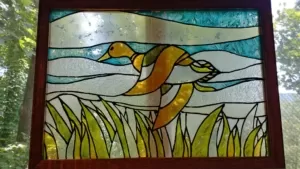Finding Affordable Arts & Crafts Stained Glass
When people think about stained glass from the Arts & Crafts era, they invariably envision a Frank Lloyd Wright geometric window designed for one of his Prairie School commissions or one of Louis Comfort Tiffany’s famous lamps or rare spectacular windows.
Odds are none of us are ever going to have either in our modest homes.

Stained Glass work done by Dianne Lee of Stained Glass Bungalow
But stained glass windows give Arts & Crafts collectors a wonderful opportunity to bring splashes of color into rooms often dominated by shades of brown. While they don’t provide the privacy you sometimes need in rooms facing your nearby neighbors – and for that you can turn to new Arts & Crafts curtains – they can work in a number of situations: hanging from a beam in a vaulted ceiling, set inside the framework to a skylight, suspended as a divider between two rooms, hung inside a screened-in porch, framed in front of a light box in a windowless basement room, built into a custom exterior door, hung across the top of a picture window or replacing a hinged transom window over a bedroom door.
When I go shopping for stained glass windows, I don’t typically start with traditional antiques shops. Instead, I track down architectural salvage warehouses, where I’m more apt to find a hundred or more windows in a variety of sizes, shapes, styles and conditions. Some will have come from local demolitions, but with those demolitions fortunately on the decline, a growing number are regularly imported from Europe.
And if you are willing to do a little work to the frame – pulling old nails, filling screw holes, refinishing or repainting the wood – you can find them at bargain prices.

A stained glass piece I found in Hillsboro, North Carolina. It now hangs in my office.
Personally, I’m not bothered by a cracked pane or two, but I have stopped buying windows with missing pieces of glass. I once took a stained glass class, thinking I could then cut and replace missing pieces, but what I learned is that it takes more than just a half-dozen night classes to learn how to properly dismantle and reassemble a stained glass window.
I also learned the hard way that removing an unwanted original window frame from around a stained glass window is not as simple as tapping the four boards apart with a mallet. In nearly every instance, multiple layers of paint had glued the outer lead channel to the wood. Instead of separating the lead channel from the wood, I separated the lead channel from the glass. Not a good idea.
If you have to remove the original wood window from around the glass, the only way I have found you can do so is by carefully cutting away the wood. The safest way is with a handsaw, but if you are experienced with a power saw and don’t mind ruining an old blade, you can make several passes – staying away from the glass – until you can then pry the last strip of wood away with your fingers.
Warning: Wear safety glasses and don’t have anyone in the room watching you. Small finish nails and broken screws buried in the wood beneath a layer of paint become flying pieces of shrapnel when hit with a whirling steel saw blade.
When cleaning paint splatters and grime off an old stained glass window, don’t assume – as many have – that steel wool, chisels or even razor blades won’t scratch glass. They will. Instead, use a glass cleaner and give it time to penetrate the paint and grime so that you can remove it using nothing more dangerous than a dishwashing pad.
Finally, if you don’t have the time or energy to scavenge for salvaged stained glass, don’t forget about the talented stained glass artists who work in the Arts & Crafts style, especially when it comes to making a particular design fit a specific opening.
Good Luck!
– Bruce Johnson
This article was originally published July 13, 2015. It has been re-published with a new picture.
